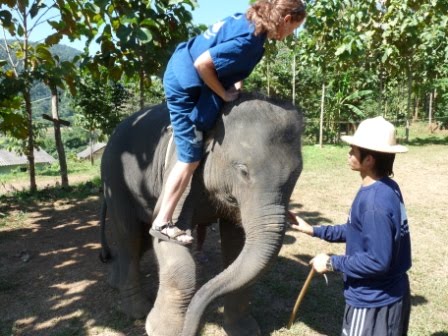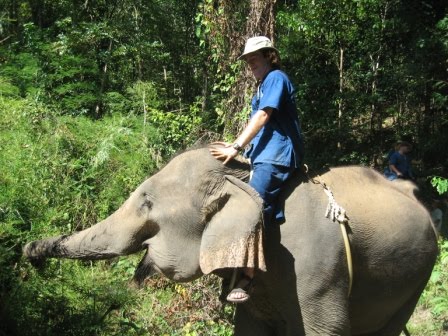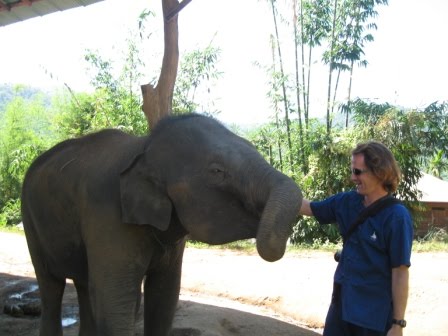We’ve been looking for the right opportunity to get up close and personal with elephants. We wanted to find a place where the elephants were not there just for tourists to sit on like an amusement park ride, and we wanted to go only where the elephants were well cared for. We found such a place outside of Chiang Mai in Northern Thailand, an elephant camp where elephants that used to work in logging, a practice which is no longer employed in Thailand, are given a new home and something to do.
Elephants are revered in Thailand. They are a cultural symbol for the country. All elephants in captivity are licensed. The Thai government has an elephant training school and a hospital where any elephants can be taken, and also traveling veterinarians because it’s tough to transport an elephant! Elephants with certain physical characteristics are considered ‘royal’ and are turned over the King.
Elephants were commonly used for logging in the past. Because of their great size and strength, they would literally push trees over with their foreheads and then drag them around with their trunks or with chains. Logging is a tough life for an elephant though, and these elephants typically only lived to about 40 years of age. If they are well cared for, elephants can live to be up to 80 years old, and so there are many of them (and their trainers called ‘mahouts’) who need work now that they are no longer logging.
The elephants here are of the Indian variety and are found in the wild throughout south Asia. Indian elephants are smaller in stature that African elephants, with bigger heads and smaller ears. It is because of their larger head (and brains) that they are highly trainable and have their famous memories (‘an elephant never forgets’).
We drove for an hour out of Chiang Mai to reach the elephant camp. There we changed into denim ‘mahout’ clothes, not only to keep ours clean, but to protect both us and our clothes from the equally abrasive elephant skin and stiff bristly hair.
On the day we visited there were six guests including us and five elephants, one of which had a baby that was six months old. We each fed all of the elephants bananas and sugar cane to that would become familiar with us and like us (yes, they do remember you and the fact that you’ve fed them).
We then received a lot of information on the lifestyle of the elephants in the camp and their behaviour, before being given detailed training on how to ride an elephant. We were here not just to get a tourist ride on the back of an elephant, but to actually sit on the elephant’s neck and to direct it like a real mahout, so we needed to learn the basic commands to mount and dismount, go forward, stop, back up, and turn left and right. Riding an elephant is done with a combination of voice commands (in a mix of Thai and local hill tribe languages), foot and leg movements, and pressure from a small bamboo stick with a hook on the end. The hook is not used to hit or hurt the elephant, but to apply sufficient pressure so that the elephant can feel it (their skin is about 2 inches thick).
Here, in a nutshell, is how to steer an elephant. To go forward, say “Pie” while resting the stick across the top of the elephant’s head and squeezing with your legs behind its ears. To go backwards, say “Toy” with a rising pitch. To turn, hold the ear opposite to the direction you want to go with your hand and also hook the top of it and pull, then kick behind the other ear. And most importantly, to stop, say “How” while resting the hook in the indent in the middle of the top of the elephant’s giant head.

Equipped with our newfound knowledge, we each took turns getting on and off an elephant. In response to a verbal command the elephant raises its right leg which we step up on while holding on to the top of its right ear. Repeating the same command get the elephant to raise its leg higher, like an elevator to the vicinity of the head. From there you kind of fling yourself leg-first over its back, and then slide forward on the neck until your legs are tight behind each ear.
A key point is that even the smaller Indian elephant is way bigger than it appears from a distance, especially when you’re scaling it or perched on its neck! We each made some turns left and right and walked forward and back to get a feel for the ride.
After lunch our plan was to ride our elephants up and down a nearby mountain. We each rode our own elephant except one couple who shared (one riding on the neck and the other on the back). Given the opportunity to share, Patrick was impressed that Diane elected to ride her own elephant. Patrick was assigned the elephant with the 6-month old baby, which seemed a bit risky. Who knows what she would do if she lost sight of her baby or if something happened to it.

We rode out of the compound and started up the hill into the jungle with Diane leading the way. The path was very narrow, and cut diagonally across the steep hill, so the downhill side was very, very far down. Patrick’s elephant was apparently hungry and was eating anything that she could get her trunk on. Unfortunately the best food was on the downhill side, so she would turn sideways on the very narrow trail and reach out over the edge as far as she could. This while Patrick was teetering at least 10 feet above the drop off! She particularly enjoyed bananas and bamboo, and not just the leaves or branches. She ate a banana tree by ripping the entire thing right out of the ground with her trunk, then dragging it along until she could consume it all. She did the same with bamboo. The 20 foot long bamboo in her mouth made it difficult for her to walk down the narrow trail as it kept snagging on trees! During our walk she ate two entire banana trees and a small forest of bamboo. Despite this feeding frenzy, she was always looking out for her baby, who usually ran along in front, but did end up behind occasionally, causing Mom to turn around and look back with Patrick on her swinging head.
Despite their size, elephants are afraid of small things that move quickly. They can startle if they see a little animal or snake, and may run quickly. We were told that if our elephant decided to go on a rampage that we should stay on it as long as possible. It’s way too high to jump, plus there’s some risk of being trampled.
Considering their size, riding an elephant is surprisingly unstable. Because the shoulders alternately rise and fall (a considerable distance) with each step, its important to sit high on the neck, just behind the huge head. The ears are like cowboy chaps, protecting the legs from passing trees. Staying on is difficult, and Patrick almost came off a couple of times. He was determined to stay mounted because he’s fallen off both a horse and a camel recently, and if he fell off an elephant too that could appear to be a bit of a bit of trend and people might start to talk…
After surviving the steep descent from the mountain we walked along a road briefly, as cars drove by. We’re not sure who was more scared — the drivers of the cars going by, vehicles much smaller than our pachyderms, or us, praying that our elephants wouldn’t startle.
We walked down to the river, and quickly doffed our hats and cameras, because the elephants weren’t stopping and were looking forward to a bath. We rode down some stairs and straight into the water, and were told how to get the elephant to sit down. It involves reaching as far back as possible and smacking the elephant on the back (their ass is way too far out of reach). Hopefully they sit just long enough for us to jump off before they start rolling in the water and crushing us.
Elephants love the water. We splashed them and they sprayed us with their trunks. We had a water fight by pointing our elephant’s snouts at one another, pausing between blasts to reload by dunking them under the water. A water fight with 2 tonne squirt guns.
In the interest of self-preservation, we needed to constantly be aware of where the elephants were and what they were doing. We were standing in the midst of a tight pack of elephants that were standing, sitting, and rolling, and it would have been easy to get squished. At one point another elephant sat on the baby, who got trapped beneath the water, and started to thrash. Although she’s only an infant, she weighed at least 700 pounds — more than enough to cause some serious damage. It was also important to stay away from the murky water and giant elephant turds that would occasionally belch to the surface!

On the ride back, within sight of the camp, Diane’s elephant started to run for no particular reason. It may have startled because a coconut was rolling on the ground. Perhaps it just did what Diane does when she’s running, which is to speed up on the home stretch (within sight of the barn!) Diane hung on until it settled down again, yelling “Ho” to no effect (the stop command is “How”).
We had a fun day and a great experience at the ‘elephant training camp’. We think that’s a bit of misnomer though, because the elephants are already trained, and it’s the tourists that need the lessons!






We've just been catching up. This is really amazing and funny as hell! It really sounds like you had a great time. So glad to hear that everything is going well and we're very much looking forward to seeing your safe return home.
Hi Dave and Meridith — We're glad that you're enjoying it. We had a great time doing it, although one day was definitely enough. See you soon.
D & P
Hi Dave and Meridith — We're glad that you're enjoying it. We had a great time doing it, although one day was definitely enough. See you soon.
D & P
What an awesome experience with those elephants. After all these excursions you two should enter for the show called “The Amazing Race”.
Hi Gail and Darren,
We’ve considered your suggestion, and decided that it would be a really bad idea. We’ve gotten pretty used to traveling together, but we don’t need the added stress to find things to disagree about. We did do a one day event like the Amazing Race in Vancouver, called the “Bell City Chase” about 3 years ago. We needed to race around Vancouver completing challenges and get back before the cutoff time. We did very actually, coming in the top third of all teams. We’d do that agan.
Stay warm!
Patrick and Diane
Wow, what a day. I always loved to ride bare back on a horse but an Elephant?? Diane don't feel bad saying Ho, at least your were close to How!! I think I would of been yelling Holy S*#T
Hi Annette – The horse is a lot narrower and a lot softer! Elephant skin is rough (except the fleshy part of the ears) and their hair is like the bristles of an industrial strength broom (the kind you use on a shop floor). Diane says that she's always had a bit of trouble with languages, especially 'elephant'.
D & P